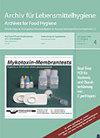从婴儿配方奶粉加工厂分离的阪崎肠杆菌的基因分型研究。
IF 0.2
4区 农林科学
Q4 CHEMISTRY, APPLIED
引用次数: 15
摘要
克罗诺杆菌是婴儿食品加工场所的偶然污染物,在罕见的新生儿感染病例中有牵连。在婴儿配方奶粉加工过程中控制这些微生物和识别可能的污染源对制造商来说非常重要。在这项研究中,2007年监测了婴儿配方奶粉加工场所是否存在克罗诺杆菌(阪崎肠杆菌)。采用ISO/TS 22964分离克罗诺杆菌,同时采用新开发的鉴别方法克罗诺杆菌筛选肉汤(CSB)分离克罗诺杆菌。利用PFGE和RAPD对环境、原料和产品中的克罗诺杆菌克隆型进行了调查,以阐明该设施内可能的传播途径。在研究过程中,从46种最终产品、23种原材料和44种环境样本中共分离出153株克罗诺杆菌。153株克罗诺杆菌有71个PFGE脉冲型,其中24个脉冲型含有多株。产品中存在的克隆分离株可以与原料和环境中难以区分的脉冲型相匹配,但没有发现同时存在于环境和原料中的菌株。虽然大多数分离株是从产品中获得的,但在原料中观察到最大的分离株多样性。这可能表明原材料是克罗诺杆菌进入生产设施的重要来源,随后选择能够在工厂环境中持续存在的菌株。本文章由计算机程序翻译,如有差异,请以英文原文为准。
Genotyping of Cronobacter (Enterobacter sakazakii) strains isolated from an infant formula processing plant.
Cronobacter spp. are occasional contaminants of infant food processing establishments and have been implicated in rare cases of neonatal infections. The control of these organisms during the processing of infant formula and identification of possible contaminating sources is of importance to manufacturers. In this study, infant formula processing sites were monitored for the presence of Cronobacter spp. (E. sakazakii) in 2007. Cronobacter were isolated using ISO/TS 22964 and simultaneously using a newly developed differential method, Cronobacter Screening Broth (CSB). Clonal types of Cronobacter strains in the environment, raw materials, and products were investigated using PFGE and RAPD in order to shed light on the possible dissemination routes within the facility. Over the course of the study, a total of 153 Cronobacter isolates were obtained from 46 end-products, 23 raw materials and 44 environmental samples. The 153 Cronobacter isolates represented 71 PFGE pulso-types, with 24 pulso-types containing multiple isolates. Clonal isolates present in products could be matched to indistinguishable pulso-types in raw materials and in the environment, however no strains were identified that were present in both the environment and raw materials. Although the majority of the isolates were obtained from products, the largest diversity of isolates was observed in raw materials. This may indicate raw materials as a significant source of Cronobacter entry into the production facility with subsequent selection for strains that are able to persist within the factory environment.
求助全文
通过发布文献求助,成功后即可免费获取论文全文。
去求助
来源期刊

Archiv Fur Lebensmittelhygiene
工程技术-毒理学
自引率
0.00%
发文量
0
审稿时长
>12 weeks
期刊介绍:
The "Journal of Food Safety and Food Quality“ provides a platform for papers including case studies and discussion papers dealing with topics from all areas of food hygiene (food originating from animals) including dairy hygiene, food monitoring, beef cattle and meat examination, meat hygiene and food technology.
 求助内容:
求助内容: 应助结果提醒方式:
应助结果提醒方式:


